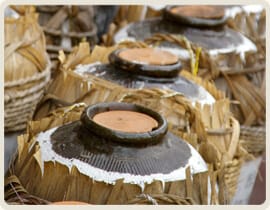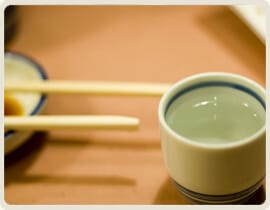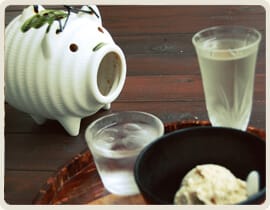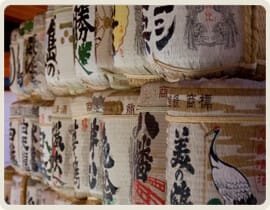- What is old sake? - Surprisingly old history of old sake
- History of old sake - Thicken the old sake and get drunk with both upper and lower body. The new sake is thin, drunk just overhead and lonely
- The taste of old sake - The taste of old sake is more mature than ordinary sake, and it has a rich and complex taste.
- Types of old sake - There are various types depending on "how to brew", "how to store and mature", "age of aging", etc.
- Make old sake - Let's make “original old sake” at home!
What is old sake?
 Currently, "old sake" often refers to Awamori's old sake
Currently, "old sake" often refers to Awamori's old sakeJapanese sake is not well known, but the history of old sake is old,
In the Kamakura period, its existence has already been recorded as a high-quality sake.
Old sake has no clear definition, and generally refers to sake that has been aged for a long time.
When only cold making was done, sake until squeezing and burning
"Sake" was called "old sake" after burning and storing until autumn.
After four seasons brewing has been carried out by improving brewing technology and improving the environment,
Based on the year of sake brewing (from the month of 7 to the end of the next year of 6),
What was made after the next fiscal year came to be called “old sake”.
Also, those with aging period exceeding 100 years are called Daikoshu.
History of old sake
 Currently, sake is generally produced and consumed within a year, but old sake is more valuable than new sake, and sake that has been aged for a long time from the Kamakura period to the Edo period is prized. It was. In the “Kumon Meng factual facts” published in 8 in Marshal, it is written that “the old sake is thick and the body is drunk and drunk. The new sake is thin and only the head gets drunk and lonely” It can be said that the old sake was highly evaluated. The old liquor disappears from the market suddenly in the Meiji era. This includes the introduction of a “stone-making tax” (which is currently taxed at the time of the sale of alcohol), which restricts the use of rice due to post-war food controls during World War II. The reason is that the environment for storing liquor was not in place. After that, the liquor tax was changed to a warehouse tax in Showa 1695, and manufacturers working on old liquor came out again. Although it is not currently on the market, many sakes such as 29 and 5 are stored in many breweries.
Currently, sake is generally produced and consumed within a year, but old sake is more valuable than new sake, and sake that has been aged for a long time from the Kamakura period to the Edo period is prized. It was. In the “Kumon Meng factual facts” published in 8 in Marshal, it is written that “the old sake is thick and the body is drunk and drunk. The new sake is thin and only the head gets drunk and lonely” It can be said that the old sake was highly evaluated. The old liquor disappears from the market suddenly in the Meiji era. This includes the introduction of a “stone-making tax” (which is currently taxed at the time of the sale of alcohol), which restricts the use of rice due to post-war food controls during World War II. The reason is that the environment for storing liquor was not in place. After that, the liquor tax was changed to a warehouse tax in Showa 1695, and manufacturers working on old liquor came out again. Although it is not currently on the market, many sakes such as 29 and 5 are stored in many breweries.
The taste of old sake
 Old sake is more mature than ordinary sake, and has a rich and complex flavor. The heavy and moderate bitterness and mellowness can be felt, and the unique flavor of old sake goes well with thick dishes using oil and meat. Various chemical and physical reactions such as oxidation and decomposition occur slowly during storage, and the degree of coloring increases from light yellow to brown over the years, so it cannot be imagined from the original sake. The flavor and color will change. Freshly squeezed fresh sake has alcohol molecules in an exposed state, so it has a stimulating and harsh taste and a fresh sake fragrance called “baba”. As the maturation progresses, the flavors of the gorgeous new liquor disappear due to the physical and chemical reactions between the ingredients in the sake, and the alcohol becomes wrapped in water molecules, resulting in a rounded and harmonious taste The color also changes to the Yamabuki color.
Old sake is more mature than ordinary sake, and has a rich and complex flavor. The heavy and moderate bitterness and mellowness can be felt, and the unique flavor of old sake goes well with thick dishes using oil and meat. Various chemical and physical reactions such as oxidation and decomposition occur slowly during storage, and the degree of coloring increases from light yellow to brown over the years, so it cannot be imagined from the original sake. The flavor and color will change. Freshly squeezed fresh sake has alcohol molecules in an exposed state, so it has a stimulating and harsh taste and a fresh sake fragrance called “baba”. As the maturation progresses, the flavors of the gorgeous new liquor disappear due to the physical and chemical reactions between the ingredients in the sake, and the alcohol becomes wrapped in water molecules, resulting in a rounded and harmonious taste The color also changes to the Yamabuki color.As it goes further, it produces a “hine scent” that closely resembles the fragrance of Chinese Shaoxing liquor, with a profound taste and color.
Types of old sake
Old liquor can be divided into various types according to “how to brew”, “how to store and ripen”, “age of aging” and so on. The following types are roughly classified into 2.
・ Fresh type
A mildly aged ginjo sake that has a light hue and a soft, gentle flavor that retains the characteristics of the original sake. The original fragrant ginjo incense remains, and the scent like the nuts obtained from aging spreads.
・ Ripe type
Sake that changes greatly with aging, brewed with rice with a relatively high percentage of polished rice such as pure rice sake and genuine brewed sake, and rich in color and flavor stored at room temperature. The aroma is close to Sherry and Shaoxing, and you can enjoy a rich aroma such as nuts, honey, and caramel.
Aging is repeated by compounding and decomposing the components of liquor, so the more components there are, the more complex changes occur, and the higher the temperature, the faster the change.
The light-ripening type has many components that are made from small chopped raw materials, so it contains few ingredients and is laid at a low temperature, so it is almost colorless, and changes in taste and aroma are gentle.
On the other hand, the deep-ripening type uses sake with a high percentage of polished rice, such as pure rice liquor and brewed sake, and preserves it at room temperature, so you can enjoy various changes depending on the aging conditions.
In addition, those that have been alternately aging at low temperature and normal temperature, refreshing liquor prepared with wine yeast and sherry yeast, sweetness with plenty of glutinous rice, liquor with a sour outline, Trial of new old sake is being promoted by aging them in barrels and making them rich in flavor and color.
Make old sake
 Usually, old sake is stored in a brewery at low temperatures for a long time, but if it is fired, it is possible to mature sake. Maturation proceeds by simply wrapping liquor with newspaper to block the light and storing it under the floor, in a cool closet, or in a refrigerator.
Usually, old sake is stored in a brewery at low temperatures for a long time, but if it is fired, it is possible to mature sake. Maturation proceeds by simply wrapping liquor with newspaper to block the light and storing it under the floor, in a cool closet, or in a refrigerator.As introduced in the previous section <Types of old liquor>, the type of old liquor varies depending on "how to brew", "how to store and ripen", "age of aging", etc. Please try making old sake.
As an environment suitable for aging sake
・ The temperature is low and constant throughout the year
・ Can block UV rays
・ No vibration
And so on.
In particular, ultraviolet rays significantly reduce the quality of liquor, so it is always necessary to take measures such as wrapping them in newspaper or putting them in a box.
